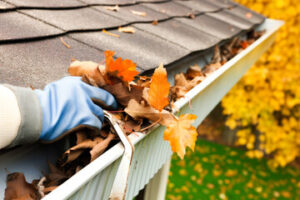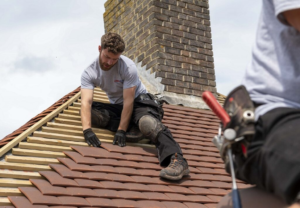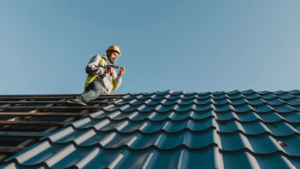Clogged gutters can lead to serious and expensive damage to your home. Gutter cleaning keeps them free-flowing and helps to prevent water damage, pest infestations, foundation cracks, roof leaks, and landscaping issues.

The best way to clean your gutters is to use a ladder and a bucket to remove the debris. A solution of vinegar and water can help to dissolve stains and break down other deposits. Contact Gutter Cleaning Gainesville FL for professional help.
Gutter cleaning involves removing the gunk that accumulates inside your gutter system. This includes leaves, twigs, pine needles and other debris that fall onto the roof and into the gutters. Over time, this builds up and blocks the flow of water into the gutters and down the drainpipes. This can cause a number of problems. For one, it can lead to overflow and water seepage. This can stain and damage the walls of your home. It can also erode the soil or mulch surrounding your house. Over time, this can lead to foundation cracks and even rot the house’s structure. Finally, clogged gutters can cause a buildup of moss and mildew that can further obstruct the flow of water.
Regular gutter cleaning can help prevent this problem. Professional gutter cleaners use a variety of tools to ensure that all the debris is removed. They start by removing the larger pieces of debris with a hand rake or broom. They then use a wet/dry vac to remove the smaller particles and dirt. They can also use a high-pressure nozzle on their garden hose to flush the gutters of any remaining debris. They pay special attention to the drainage outlets where the gutters connect with downspouts to redirect water. They test for complete drainage by pouring water over the gutters to confirm that they are completely clear.
The most obvious sign that your gutters are in need of a clean is overflowing during a rainstorm. However, there are several other signs that you should keep an eye out for. These include discoloration or mold around the exterior walls of your home, damp or rotting fascia boards, and weeds growing in the gutters or along the ground. If you notice any of these issues, it’s a good idea to schedule gutter cleaning services as soon as possible. The longer you wait, the worse the problems will become. In addition, if the gutters and downspouts are clogged, water will be directed away from your home rather than being redirected into the drainage system. This can lead to ponding water or even a flooded basement.
Pest Infestations
Clogged gutters create ideal breeding grounds for mosquitoes, gnats, rodents, and other pests. Many of these pests can carry dangerous diseases that pose a risk to the health of your family and pets. They also can cause extensive damage to your property. Pest infestations often result from neglecting gutter cleaning, and this can lead to costly home repairs.
Gutters are designed to channel water away from the foundation, walls, roof, and other structural areas of your home. However, if these gutters are clogged, rainwater will seep into the structure of your house and cause significant damage over time. This can lead to mold and mildew growth, as well as deterioration of the roof structure. Gutter cleaning ensures that rainwater is properly channeled away from your house, protecting it from damage and preventing health issues for your family.
The buildup of leaves, pine needles, dirt, and other debris in your gutters can cause them to become clogged. This can prevent rainwater from flowing freely, and it may also cause the gutters to rust or break down. Clogged gutters can also cause water to overflow, which may damage the side of your house and the landscaping around it. Gutter cleaning helps prevent these problems by keeping the gutters free from debris.
Another problem associated with gutter neglect is a flood of rainwater that infiltrates your foundation and basement. Over time, this can cause serious structural damage to your house and even lead to foundation cracks or sinkholes. This can lead to expensive repairs that you may be unable to afford.
In addition, a flooded gutter can also cause water to seep under the shingles and into the roof structure. This can lead to rot, deterioration of shingles, and roof damage that will require costly repairs. Gutter cleaning can help prevent these problems by keeping the gutters free of debris and preventing overflowing rainwater. Gutter maintenance also includes installing gutter covers that will protect the underlying structure from water damage.
Damage to the Roof
Gutter systems are designed to do two things: divert water from the roof surface and drain it away through downspouts. When these systems become clogged, the roof, roofing structure, siding and foundation are at risk of damage. When water is not efficiently drained, it will soak into the roof, seep through shingles and cause wood rot to fascia boards and the structure of the home.
Water spilling over clogged gutters can also lead to soil erosion and cracks in the foundation. These issues are costly to repair and can affect the longevity and integrity of the roof and home. Regular cleaning prevents these problems and keeps the roof healthy, extending its lifespan.
Gutters that aren’t cleaned regularly can also trap debris, creating a humid environment where mold and mildew thrive. This can stain and discolor the gutters and surrounding masonry, making them look unsightly and unattractive.
Dirty gutters are also a nesting place for rodents, bugs and snakes. Rodents and pests can chew through gutter material, causing damage to the roof and home. They can also create a breeding ground for flies, mosquitoes and other annoying pests.
Regular gutter cleaning can help keep the home and its roof in good shape, prolonging their life and reducing costly repairs down the road. The best time to schedule cleaning services is during the spring and fall. It is recommended that homeowners have their gutters cleaned at least twice per year, preferably more often if they live in an area with many trees.
If you decide to clean the gutters yourself, use a tall ladder that extends at least three feet over the gutter and secure it on even ground, ideally on pavement. Make sure that you’re wearing protective gear such as a long-sleeve shirt and work gloves. Always be careful when climbing a ladder, and it’s a good idea to have another adult available to assist you in case you need to leave the ladder or get off of it for any reason.
A professional gutter-cleaning service will use a ladder to mount the roof and remove debris from the gutters and downspouts. Then they’ll test each downspout to ensure it’s clear of blockage and, if necessary, will disassemble the downspout and remove the clog. They’ll also inspect the gutters for damage, including corrosion and rust. They’ll also install downspout extensions if necessary to redirect water flow from areas where it can cause damage.
Water Damage
Water damage is one of the most expensive and frustrating problems homeowners face. It sneaks up on you, slowly destroying your valuable belongings and causing costly structural damage to your home. This is often the result of neglected gutters, which become clogged with leaves, twigs, and dirt and fail to direct rainwater away from your home properly.
When this happens, rainwater overflows and spills onto the sides of your home and down its foundation. This seepage can damage your furniture, carpets, and other belongings stored in the basement. It can also saturate the soil surrounding your home, leading to foundation cracks and structural issues over time.
Overflowing water can also cause mold and mildew growth. These fungi thrive in moist environments and release spores into the air, which can irritate your lungs and throat as well as lead to other health issues. Fortunately, regular gutter cleaning can prevent these problems by keeping your gutters clean and directing rainwater away from your home.
Clogged gutters can also damage the roof, siding, fascia boards, and soffits of your home. As the water overflows and splashes against these surfaces, it can leave behind unsightly stains and peeling paint as well as create holes in your roofing system. If you have a leaky roof or other problem areas, cleaning the gutters will often reveal the source of the problem and allow you to repair it before the damage worsens.
If you don’t want to deal with the hassle of cleaning your own gutters, you can always hire a professional service to do it for you. Be sure to choose a trustworthy company that uses proper safety precautions and has years of experience. Some companies may use pressure washing, vacuuming, or manual cleaning techniques to ensure that they remove all of the debris from your gutters and downspouts. If you prefer to do it yourself, be sure to use a ladder that’s sturdy and secure, wear eye protection, and keep your pets and children away from the area while you work. And remember that rinsing the roof with a garden hose afterward is a great way to make sure your gutters are completely clean and free of debris.

